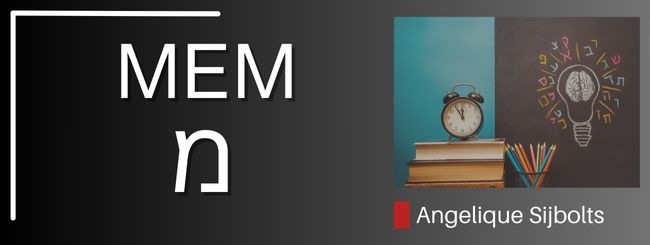
Last time, we learned the ג of gimel. We already know the lamed ל. This time we are going to look at the mem מם .
The letter mem has two forms, the common form מ and the form as it occurs at the end of a word. The mem-sofit – the slot-mem ם.
The Gimel has the sound of “m”.
The gematria is 40.
The open מ points to the obvious, openly revealed glory of HaShems actions. The closed ם alludes to that part of the celestial rule which is concealed from man, and to wich man submits instinctively and with perfect, innocent faith. The open מ also stands for revealed Torah and the closed ם for Kabbalah and Chassidus.
One of Hashem’s Names is “Makom” מָקוֹם [literally the place] This Name indicates that He infuses every place of the world. Everything is full of His glory and He is King/ Melech מֶלֶךְ and Ruler over all and everything. Over all that is revealed and in all that is concealed.
As shown above, the mem displays the number 40. It represents a transition phase. The rain of the flood lasted 40 days and nights to cleanse the world of its sins. The people were in the desert for 40 years to leave the confines of Egypt and enter the land of freedom. Moses was 3x 40 days and nights on Mount Sinai. To receive the Torah, to pray for forgiveness and to do Teshuvah (1 acknowledging the mistake, 2promising that it will not happen again,3 and compensation for the damage)
40 Days and nights of intensive study, with everything within us, of the Torah/ of the 7 Noahide Laws, allows us to detach ourselves from our past and feel in the presence of Mount Sinai. *
Praying 40 Days and Nights, with all that is within us, makes us build a deep relationship with Hashem.
40 Days and nights of Teshuvah shows its sincerity and makes a firm foundation to prevent unwanted repetition.
We are now familiar with the:
ב י ת א ל פ ף ג מ ם .
and with the:
ִ ּ ֶ ָ ַ ֵ ֹ
[ i, dagesh, e, aa, a, ee, o ]
and can now read the following words, among others:
Genesis 1:6
וַיֹּ֣אמֶר אֱלֹ”הִ֔ים יְהִ֥י רָקִ֖יעַ בְּת֣וֹךְ הַמָּ֑יִם וִיהִ֣י מַבְדִּ֔יל בֵּ֥ין מַ֖יִם לָמָֽיִם׃
G-d said, “Let there be an
expanse in the midst of the water, that it may separate water from water.”
Genesis 24:63
וַיֵּצֵ֥א יִצְחָ֛ק לָשׂ֥וּחַ בַּשָּׂדֶ֖ה לִפְנ֣וֹת עָ֑רֶב וַיִּשָּׂ֤א עֵינָיו֙ וַיַּ֔רְא וְהִנֵּ֥ה גְמַלִּ֖ים בָּאִֽים׃
And Isaac went out walking in the field toward evening and, looking up, he saw camels approaching.
גָּמָל
Is a camel, male singular
גְּמַלִּים
Are camels, masculine plural.
-ים
The masculine plural is formed by the suffix
Exodus 20:10
When you know that (-cha) ךָ is the suffix which represents the possessive masculine pronoun singular, we can read the following words from the following sentence.
כַּבֵּ֥ד אֶת־אָבִ֖יךָ וְאֶת־אִמֶּ֑ךָ לְמַ֙עַן֙ יַאֲרִכ֣וּן יָמֶ֔יךָ עַ֚ל הָאֲדָמָ֔ה אֲשֶׁר־יְהוָ֥ה אֱ”לֹהֶ֖יךָ נֹתֵ֥ן לָֽךְ׃
Honor your father and your mother, that your days will be prolonged in the land that your G-d Hashem is assigning to you.


By Angelique Sijbolts
Sources: ChabadVideo, The Wisdom in the Hebrew Alphabet Grammatica vh Bijbels Hebreeuws by E. Lettinga, Grammar For Biblical Hebrew by C. Seow
© Copyright, all rights reserved. If you enjoyed this article, we encourage you to distribute it further.
